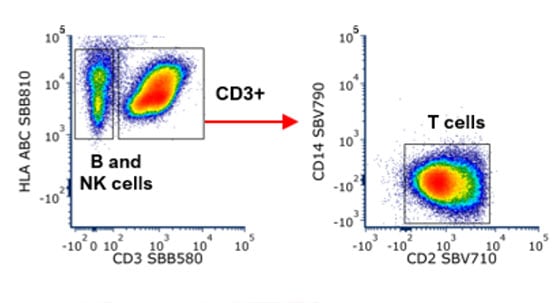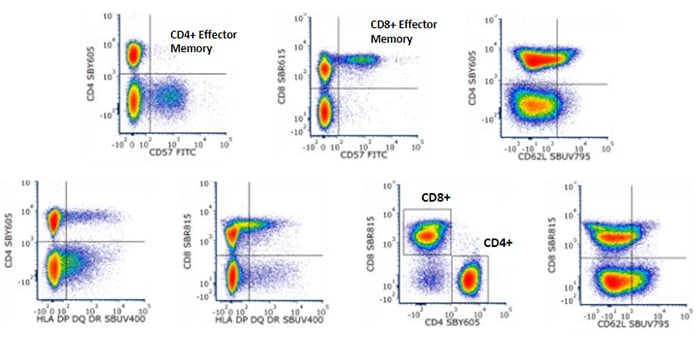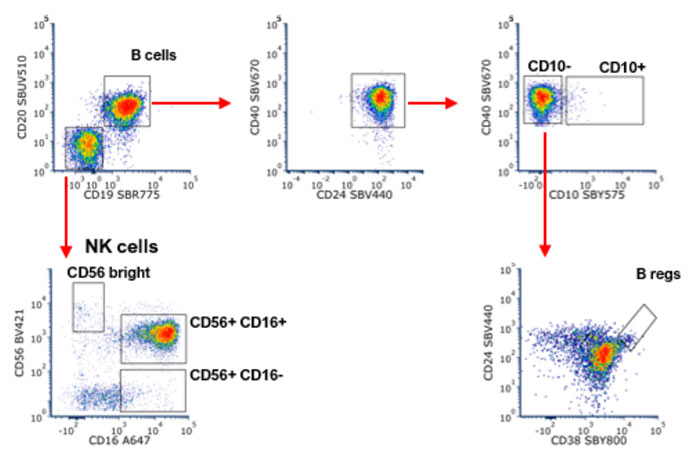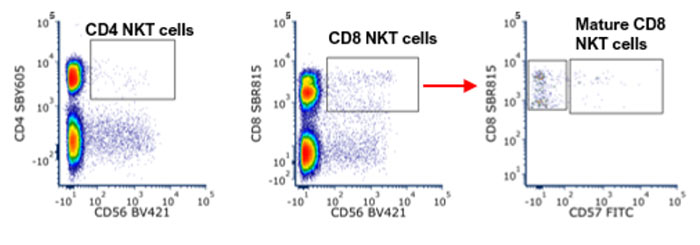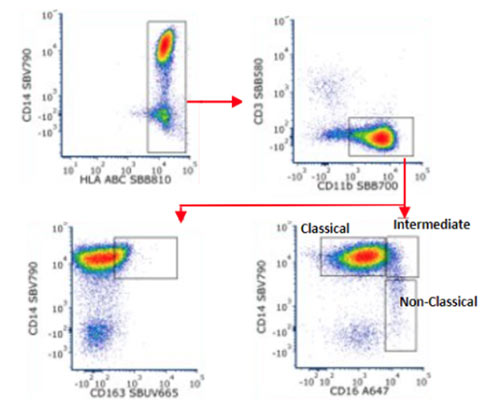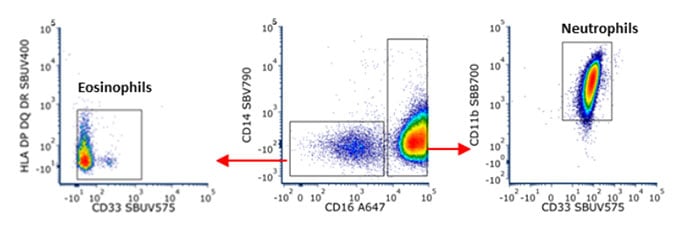What is Immunophenotyping?
Immunophenotyping is the characterization and classification of cells in a heterogeneous mixture of cells such as blood, synovial fluid, other aqueous liquids, or solid tissues. It uses the expression of specific genes and combinations of genes to categorize cell types based on known functional characteristics.
-

Want to Talk About Immunophenotyping with Flow?
If you already know what you are looking for and would like to discuss this topic with one of our flow cytometry experts, then get in touch.
The Perfect Balance of High Parameter Data & Speed with Reproducibility
High Parameter Data
With up to 5 lasers and 30 parameters, the ZE5 Cell Analyzer can perform immunophenotyping in depth. In this example, we show a 27-color immunophenotyping panel designed using our cutting edge StarBright™ Dyes to characterize the major human leukocyte sub populations. You can also download the full PDF poster and a technical note with methods and additional data.
27-Color Immunophenotyping Panel Including StarBright, UltraViolet, Violet , Blue, Yellow, and Red Dyes
| Target | StarBright Range | Fluorescent Dye | Product Code |
|---|---|---|---|
| HLA DP DQ DR | UltraViolet | SBUV400 | MCA477SBUV400 |
| CD20 | UltraViolet | SBUV510 | MCA1710SBUV510 |
| CD33 | UltraViolet | SBUV575 | MCA1271SBUV575 |
| CD163 | UltraViolet | SBUV665 | Coming soon |
| CD28 | UltraViolet | SBUV740 | MCA709SBUV740 |
| CD62L | UltraViolet | SBUV795 | MCA1076SBUV795 |
| CD56 | N/A | BV421 | N/A |
| CD24 | Violet | SBV440 | Coming soon |
| CD45RA | Violet | SBV515 | MCA88SBV515 |
| CD45RO | Violet | SBV610 | MCA461SBV610 |
| CD40 | Violet | SBV670 | Coming soon |
| CD2 | Violet | SBV710 | MCA1194SBV710 |
|
CD14 |
Violet |
SBV790 |
|
| CD57 | N/A | FITC | MCA1305GA |
| CD3 | Blue | SBB580 | MCA463SBB580 |
| CD11b | Blue | SBB700 | Coming soon |
| HLA ABC | Blue | SBB810 | MCA81SBB810 |
| CD10 | Yellow | SBY575 | MCA1556SBY575 |
| CD4 | Yellow | SBY605 | MCA1267SBY605 |
| CD45 | Yellow | SBY665 | MCA87SBY665 |
| CD27 | Yellow | SBY720 | MCA755SBY720 |
| CD38 | Yellow | SBY800 | MCA1019SBY800 |
| CD16 | N/A | A647 | MCA5665A647 |
| CD31 | N/A | A700 | MCA1738A700 |
| CD19 | Red | SBR775 | Coming soon |
| CD8 | Red | SBR815 | Coming soon |
| PI | N/A | L/D | 1351101 |
Initial Plots

27-Color Multiplex Panel. Red blood cell lysed human peripheral blood was stained with a live/dead dye (propidium iodide, (PI)) and a 26-color antibody panel in FACS Buffer allowing identification of multiple cell lineages and subsets.
Full Gating Strategy
Click each image to see the full gating strategy:
Speed with Reproducibility
The ZE5 Cell Analyzer can acquire complex immunophenotyping data at rates that significantly exceed conventional instruments. Its innovative fluidics and electronics synergize to enable it to process a 96-well plate in less than 15 minutes whilst still being able to collect tens of thousands of events per well. This means that even complex assays such as the one detailed above can be performed at the speed of a screening instrument and without compromising reproducibility.
To demonstrate this, we repeated the 27-color panel shown above using high throughput mode for sample acquisition. The data shows a high level of reproducibility between high throughput runs and is consistent with standard mode runs. Whilst data quality was preserved the run time for each well was reduced from 3 minutes 21 seconds in standard mode, to 8 seconds in high throughput mode.
Example 27-Color Panel Comparison of Standard and High Throughput Data Acquisition
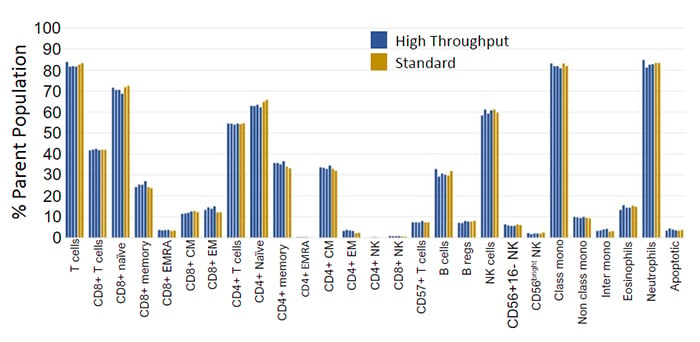
This example shows six replicates of the 27-color panel data shown previously, a single sample was collected in high throughput (n=4) and standard mode (n=2). Each standard mode replicate was collected in 3 minutes and 21 seconds, while each high throughput mode replicate was collected in 8 seconds.
-

Unlock the Power of High Speed Immunophenotyping
Contact a flow cytometry specialist to discuss how the ZE5 Cell Analyzer can deliver a significant increase in the quantity and quality of your immunophenotyping data.
Powerful Instruments with Cutting Edge Dyes
For the ultimate synergy of instrument and reagents combine the speed and power of the ZE5 Cell Analyzer with our range of innovative StarBright Dyes.
-
Image

-
Image

Additional Resources
Explore other example immunophenotyping panels analyzed using the ZE5 Cell Analyzer and see how StarBright Dyes can enhance any panel on any instrument. Includes detailed immunophenotyping protocols.
StarBright Dyes: Build Bigger, Better Panels With Superior Dyes Posters
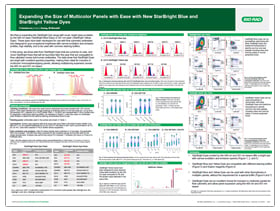
StarBright Dyes: Excitable by the Blue & Yellow Lasers
11-color panels introducing StarBright Blue and StarBright Yellow Dyes on the ZE5 Cell Analyzer.
Download PDF StarBright Dyes: Excitable by the Blue & Yellow Lasers
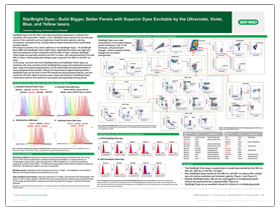
StarBright Dyes: Excitable by the UltraViolet, Violet, Blue & Yellow Lasers
23-color panel built using only antibodies from Bio-Rad and the ZE5 Cell Analyzer.
Download PDF StarBright Dyes: Excitable by the UltraViolet, Violet, Blue & Yellow Lasers
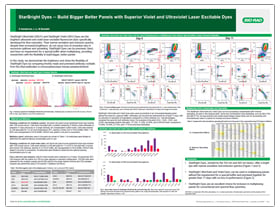
StarBright Dyes: Excitable by Violet & Ultraviolet Lasers
Poster comparing the stain index of StarBright Dyes to dyes from other vendors, and the effect of pre-mixing antibody cocktails containing StarBright Violet and UltraViolet Dyes compared to freshly made up cocktails.
Download PDF StarBright Dyes: Excitable by Violet & Ultraviolet Lasers

StarBright Dyes & the ZE5 Cell Analyzer: Generating Fast, Reproducible, High Resolution Flow Cytometry Data
27-color panel built using StarBright Ultraviolet, Violet, Blue, Yellow, and Red Dyes and assayed using the ZE5 Cell Analyzer. This poster demonstrates the stability of premixed StarBright Dyes over 6 months and the excellent data reproducibility achieved when performing complex immunophenotyping at high speed
Flow Immunophenotyping Tools & Services
Building new immunophenotyping panels can be challenging. We have developed a range of resources that can help you get the most out of your flow cytometer regardless of manufacturer or configuration.
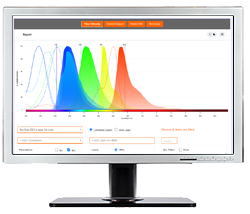
Spectraviewer
Check fluorophore compatibility and avoid excessive cross-laser excitation and compensation
-

Panel Builder
Design the right panel for your instrument quickly and easily
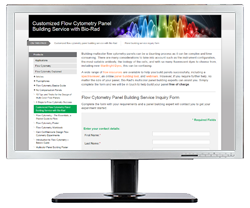
Custom Free Flow Cytometry Panel Building Service
Don’t know where to start? Get in touch and we will be happy to design a custom panel specific to your needs
Further Reading
Quantification of T cell Subsets in Stem Cell Transplant Patients Using a 21-Color Panel
A 19-Color Panel for the Immunophenotyping of Normal and Malignant Leukocytes by Flow Cytometry
-

Uncover your Immunophenotyping Capacity using Flow Cytometry
Looking for something else or would like to discuss what you need with a flow cytometry expert?








